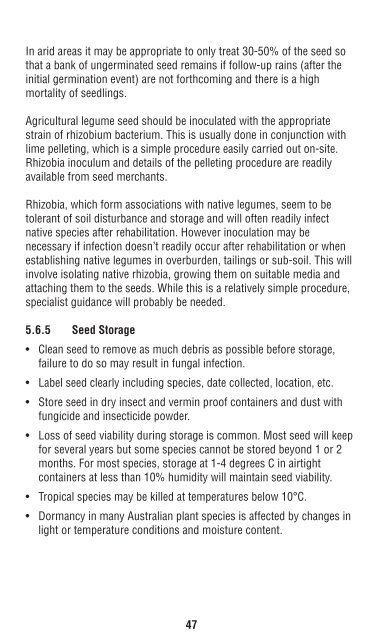Mine Rehabilitation Handbook - Mining and Blasting
Mine Rehabilitation Handbook - Mining and Blasting
Mine Rehabilitation Handbook - Mining and Blasting
Create successful ePaper yourself
Turn your PDF publications into a flip-book with our unique Google optimized e-Paper software.
In arid areas it may be appropriate to only treat 30-50% of the seed so<br />
that a bank of ungerminated seed remains if follow-up rains (after the<br />
initial germination event) are not forthcoming <strong>and</strong> there is a high<br />
mortality of seedlings.<br />
Agricultural legume seed should be inoculated with the appropriate<br />
strain of rhizobium bacterium. This is usually done in conjunction with<br />
lime pelleting, which is a simple procedure easily carried out on-site.<br />
Rhizobia inoculum <strong>and</strong> details of the pelleting procedure are readily<br />
available from seed merchants.<br />
Rhizobia, which form associations with native legumes, seem to be<br />
tolerant of soil disturbance <strong>and</strong> storage <strong>and</strong> will often readily infect<br />
native species after rehabilitation. However inoculation may be<br />
necessary if infection doesn’t readily occur after rehabilitation or when<br />
establishing native legumes in overburden, tailings or sub-soil. This will<br />
involve isolating native rhizobia, growing them on suitable media <strong>and</strong><br />
attaching them to the seeds. While this is a relatively simple procedure,<br />
specialist guidance will probably be needed.<br />
5.6.5 Seed Storage<br />
• Clean seed to remove as much debris as possible before storage,<br />
failure to do so may result in fungal infection.<br />
• Label seed clearly including species, date collected, location, etc.<br />
• Store seed in dry insect <strong>and</strong> vermin proof containers <strong>and</strong> dust with<br />
fungicide <strong>and</strong> insecticide powder.<br />
• Loss of seed viability during storage is common. Most seed will keep<br />
for several years but some species cannot be stored beyond 1 or 2<br />
months. For most species, storage at 1-4 degrees C in airtight<br />
containers at less than 10% humidity will maintain seed viability.<br />
• Tropical species may be killed at temperatures below 10°C.<br />
• Dormancy in many Australian plant species is affected by changes in<br />
light or temperature conditions <strong>and</strong> moisture content.<br />
47<br />
5.6.6 Seedbed Preparation<br />
Methods used for the preparation of the seedbed will depend on<br />
topography of the site, the proposed l<strong>and</strong>use, the extent of soil<br />
amelioration <strong>and</strong> fertiliser use, <strong>and</strong> the sowing or planting technique<br />
proposed. The objective in creating a seedbed is to place the seed in a<br />
suitable place for germination. Points to consider include:<br />
• Prevent compaction, crusting <strong>and</strong> subsequent erosion by avoiding<br />
disturbance to soils when wet <strong>and</strong> sticky or dry <strong>and</strong> powdery.<br />
• Application of most fertiliser can be carried out during tillage of the<br />
seedbed. Nitrogenous fertilisers tend to dissipate to the atmosphere<br />
<strong>and</strong> planting should follow immediately after application.<br />
• Timing of seedbed preparation (<strong>and</strong> sowing) is often critical for<br />
successful establishment of vegetation. In most cases preparation<br />
<strong>and</strong> sowing should occur prior to the onset of “reliable” rainfall.<br />
• Where the topsoil contains significant quantities of seed of desirable<br />
species, care must be taken not to disturb the soil after these seeds<br />
have started to germinate, as this will cause a substantial reduction<br />
in plant establishment.<br />
• In southern or alpine areas, soil temperatures also need to be<br />
considered. Local agricultural practices may provide a guide to the<br />
optimum period.<br />
• A variety of heavy-duty conventional agricultural equipment can be<br />
used for seedbed preparation. Disk harrows <strong>and</strong> chisel ploughs are<br />
both able to operate in stony soil conditions.<br />
• Avoid “over preparing” the seedbed. A rough “cloddy” surface<br />
reduces runoff <strong>and</strong> provides better lodgement <strong>and</strong> protection for<br />
seeds <strong>and</strong> seedlings.<br />
• When h<strong>and</strong> planting of seeds or seedlings is proposed, site<br />
preparation may best be limited to deep ripping or minimal tillage.<br />
48
















